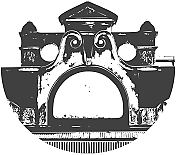They don't advertise for killers in the newspaper
“I am really turning into a moth. The light on my phone keeps me searching for truth in all the wrong places...”
Nick Drake considers the urban landscape of Brisbane—and the people who occupy it—with distrust and intrigue. Sourcing visual material for his paintings with his smart-phone during late night misadventures in the city, Drake specifically pursues and captures images of people he believes to be ‘letting their hair down or who are up to no good.’
Often these people are strangers who are thought to have ominous motives in the night, or the artist's friends who are having a late-night alcoholic beverage. What the two have in common for Drake is their potential to spark storytelling within the context of the urban landscape. He intends that the figures charge his chosen scenes with suspicion and curiosity, so as to extend his interests in landscape painting by introducing an implied narrative element. The presence of people also infuses the paintings with a sense of familiarity that comes from the viewer knowing of these ubiquitous urban environments.
Drake's smart-phone camera is a hassle-free, non-interventionist method of interacting with the city-dwellers that allows him to take on the guise of a dodgy private detective or to emulate photojournalists such as Weegee. Digital photography is also an effective abstractor of light that can be further exaggerated within his paintings. Poor-quality images taken with simple apparatus and little photographic training are advantageous to the artist, as imperfect qualities such as light bleeds and over-saturation are appreciated and can be magnified with his brush-strokes. The movement of light captured in the photographs and ultimately transposed in the paintings only aid to convey the city as unstopping and overwhelming. The artist's sceptical relationship with the city, and its dwellers, combines with the qualities of his photographic documentation to generate his paintings, creating a visceral depiction of the city late at night.
Drake favours night scenes not only for the atmosphere that they create, but also for practical reasons: sunlight bleaches out the strong colours that he is drawn to, whereas the night enhances bold lights and darkens menacing crevices. Ironically, the painting's garish colours make it difficult to distinguish between day and night however this is unimportant; what he is favours is the preferable aesthetic qualities and the opportunities to interact with denizens that the night provides.
The abstraction of form and colour in Drake's paintings draws influence from the Expressionist movement, which notably distorted forms and deployed strong colour palettes to convey anxieties and yearnings associated with lost feelings of authenticity and spirituality. Painting can certainly convey feelings and give clues to an experience, and Drake's strong lines and garish colours reveal uneasy truths about reality and a sense of anxious foreboding. The city is radically distorted to express subjective meaning and emotional experience rather than factual realism. Drake's paintings are a compelling account of his own experience of the city, where a stroll to the 7/11 over the street is marred by potential run-ins with muggers and cops.
The exaggerated brush lines and bold colours equate to an exaggeration of the reality captured in Drake's photography - but for him this is the actual truth that he finds in the night. Drake considers his method of painting from photographs to be a subversion in the course of pure engagement, in which he can heighten the viewer's experience of reality with his own stubbornness to accept things as they are. He seeks to reveal that the prophecy of toxic urbanization seen in films such as Bladerunner is upon us, and that we need to get used to the disheartening reality of vast plains of concrete and people with bad intentions moving among us.
Nicole Gillard 2015

